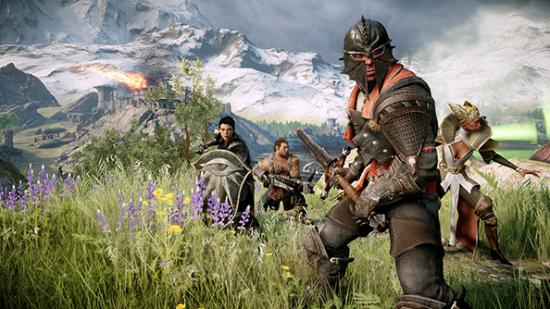There’s a big glowing hole in the sky and terribly evil things keep falling out of it. Demons, ghosts, rude lyrics, all manner of insane badness is tumbling out of an inter-dimensional sky-fanny and it’s up to you, the leader of the Inquisition, to find out why it’s happening and put a stop to it. This is Dragon Age: Inquisition, BioWare’s second shot at giving Dragon Age: Origins the sequel it deserves, one that draws on both the freshly Skyrim and Witcher-soaked influences of a recently rejuvenated fantasy RPG genre, as well as building on its own tactically minded combat roots. This is a next-gen Dragon Age that’s grown up, learned its lessons and added a horse.
BioWare snapped through some bullet points at the top of their hands-off presentation, listing off their goals for the next Dragon Age game. It’s a world filled with dilemma and choice, they intone, one in which magic is dangerous and something called a Fade Tear terrorises the realm. This shimmering emerald aurora is a demonic ribbon visible in different locations throughout the game, and despite the threat it poses, the nations and races of Dragon Age seem preoccupied with their own internal affairs and piffling wars. Ain’t nobody got time for world-ending Fade Tears, it seems, and that, BioWare prod, is rather suspicious.
So you lead the Inquisition, a ministry of ancient peacekeepers, in an effort to solve this mystical conundrum and save the world. You can choose to be a man or a woman, an elf, a human, a dwarf or a qunari (and not, as my notes say, a canary – though how cool would that be?) as you take on the role of an entirely new character with (mostly) new followers and all new stories to be told. BioWare are vague on exactly how much existing Dragon Age plot will carry over to Inquisition, preferring to present the game as its own original adventure.
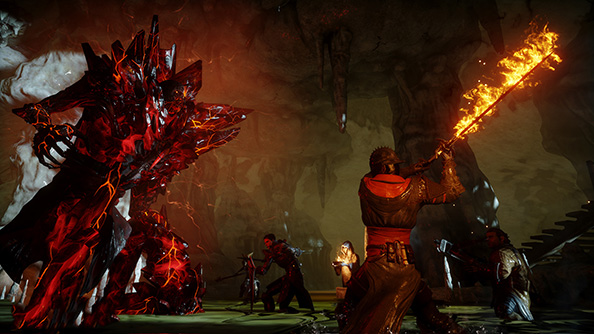
The physical world is huge, hugerer than ever, and as the presentation opens above the rolling plains of Crestwood we’re told that this area alone is larger than all of Dragon Age 2’s areas put together. Later we’d be shown the Western Approach, a vast desert location pocked with caves, inhabited by nomadic cultists and scarred by a deep, sulphur spewing canyon. Back in Crestwood, producer Cameron Lee announced that it would take fully 15 minutes to walk across this location on foot, which seemed to be the ideal cue to introduce the game’s new mounts (so far, only horses are confirmed), but instead he trekked onwards on his pins, encountering bandits and triggering incidental banter between his character and his followers.
You can smack and stab enemies manually, running up to them and mashing keys until one of you is dead. Followers will happily use their AI to automatically back you up in these situations, tackling opponents, casting spells and swinging swords, though you can instantly switch into their bodies to control their attacks and movements. Should this third-person scrapping feel too rudimentary however, BioWare are proudly reintroducing the tactical combat of the original game, cutting it with the dumb-brawling of the second game to create a powerfully useful combat engine.
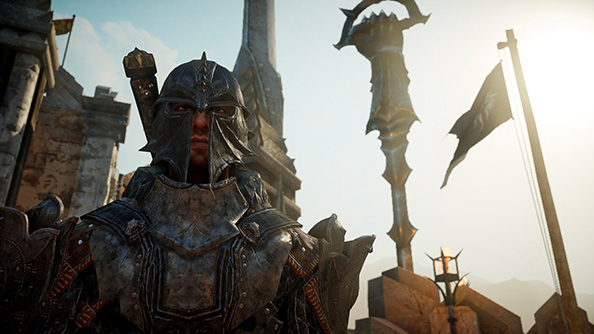
In a later fight the game’s presenter pulled the camera out to a frozen, overhead viewpoint, revealing the battlefield before our team of fighters and allowing him time to devise a plan. A row of archers could be spied, as well as a mage standing just ahead of them. By directing our own mage to cast an ice wall between the enemy ranks, the player could temporarily block the line of archers and focus his attacks on the dangerous spellcaster.
In another encounter, with a big stone golem who’d smashed through a cave wall just to fight with us, the player eschewed the tactical camera but demonstrated how he could continue to fight strategically by switching between characters, casting armour-sapping debuffs and aggro-increasing taunts before pummeling the rock-giant to bits. The two approaches to combat, at least from my seat, appeared to complement one another in a useful manner: the less intensive third-person fighting lends itself to incidental encounters with time-wasting garbage goons, while the time-stopping tactical mode allows perfect, fine control during the more challenging battles with multiple enemies.
You can often choose to avoid battles. The reason our band of adventurers had stopped at Crestwood is because the town was being battered by some Red Templars, a group of morally corrupt baddies. Happening upon a group of Crestwood soldiers with their guts half out, you’re given the option to tend to the wounded, defend the town or defend the keep, which is the Inquisition’s vitally important stronghold in the area. Here’s a very specific picture of that decision being made. Look at that lovely helmet.
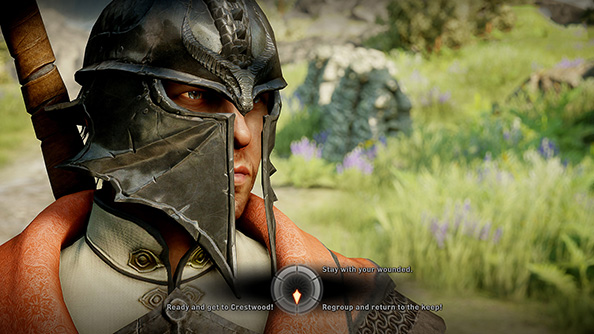
Depending on your choice and your ability to follow through on your promises, one of a number of things can happen. That number of outcomes, in the case of Crestwood, is “four or five” according to BioWare, and the consequences of your actions are “far-reaching and permanent”. In the playthrough, for example, our hero decided to look after his own, opting to defend the Inquisition’s keep and allowing the town of Crestwood to be roundly massacred in the process. There’s a cutscene shortly after that in which a dwarf, one of your followers, looks very upset about all the dead bodies, handing you a one way ticket to guilt trip central, stopping at regret junction and maybe-I-should-quickload… boulevard.
Some decisions are more subtle than that. You have a chance to set fire to the Red Templar’s boats as they’re moored by Crestwood, which we’re told prevents their retreat and subsequent reinforcement. A stone dam above a lake is pointed out to us as we’re tantalisingly informed that destroying it would have huge repercussions for the entire area. It survives the playthrough, but the destructibility of other objects are more readily highlighted: at one point a large gate is bulldozed by our tank character (a rogue could’ve climbed the keep’s wall to unlock the gate from the inside, alternatively), and in a battle soon afterwards we destroy a bridge to send three archers tumbling to a splintery and sort of obvious death.
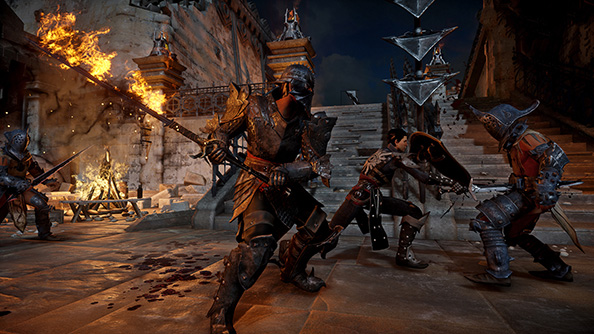
Liberating keeps and establishing new ones is an ongoing job in Inquisition and a large part of your job as an Inquisitor. Once you’ve taken over a keep you can recruit and station agents there before customising the stronghold to specialise in either military, commercial or espionage. With enough agents you can take on missions in the surrounding area, constructing something called a Shattered Colossus to boost morale, or unlocking a new route, or capping the sulphur mines in the Western Approach’s canyon to gain a useful natural resource and open the area up for exploration. That you can actually walk around your keeps and say hello to all of your Inquisition buddies is a pleasant touch.
What else? Some odd features stood out during the presentation: HP no longer regenerates between battles, and health potions are more scarce. There are special “veilfire” torches that reveal secret glyphs on cave walls throughout the game. Enemies aren’t scaled to match your character’s level, so there will be areas naturally off limits to low-level players.
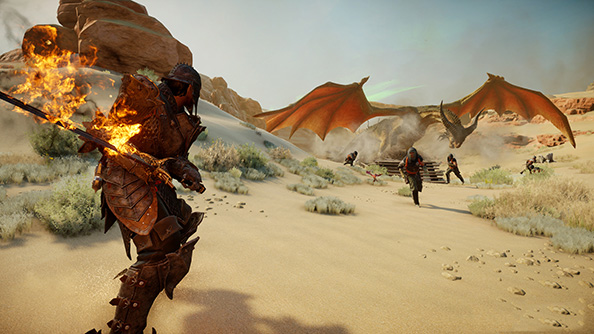
Oh, and there are dragons. Special, “hand-crafted”, fire-breathing dragons. None of your factory-built dragons for Inquisition, oh no. BioWare also say they refuse to devalue their dragons by having them show up randomly in the wild, a la Skyrim, instead their dragons are special and unique creatures. They must be discovered and fought and murdered for special prizes, though, and this is especially true given that the game won’t be levelling these dragons to match your abilities, BioWare promise that taking one down will be one of the biggest challenges in the game. The presentation faded to black just as one dragon was getting particularly rowdy, another secret to be paraded at a later date. It’s clear that BioWare are holding cards close to chests, with repeated assertions that what we were seeing was very early code.
The impression is that Dragon Age: Inquisition has studiously embraced criticism of the most recent game, acknowledged the love fans have for the original, respectfully observed the new fantasy world standards set by Skyrim and The Witcher, all while being quietly confident enough to retain the series’ core value of being able to have sex with loads of people near some dragons. Whether BioWare can come good on that promise and deliver the Dragon Age sequel the series deserves, however, is almost entirely unknowable at this stage. Don’t believe anything anybody says to the contrary. Previews!
Dragon Age: Inquisition is over a year away, with a planned release in Autumn of 2014. It will launch on PC, old consoles and new consoles, basically every kind of console except for the Nintendo one that nobody likes.
